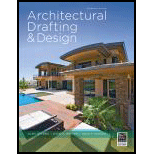
DIRECTIONS: Answer the following questions with short, complete statements or drawings as needed on an
1. Letter your name, Chapter 22 Test, and the date at the top of the sheet.
2. Letter the question number and provide the answer. You do not need to write out the question.
3. Answers should be based on the code that governs your area, unless otherwise noted.
Sketch and define the difference between a hip and a Dutch hip roof.
Want to see the full answer?
Check out a sample textbook solution
Chapter 22 Solutions
Architectural Drafting and Design (MindTap Course List)
- FIND THE INTERNAL MISSING ANGLES AND MISSING SIDESOF A 90° RIGHT TRIANGLE WITH A HEIGHT OF 96 AND A BASE OF 48.DRAW A PROPORTIONAL SKETCH OF THE TRIANGLE, IDENTIFY GIVEN INFORMATIONAND LABEL MISSING INFORMATION. WHAT IS AREA TO THE NEAREST SQ. FT.?arrow_forward2,789.10 FEET = HOW MANY METERS (M)?arrow_forward87.74529° TO DEGREE‐MINUTE‐SECOND FORMATarrow_forward
- Draw shear and moment diagramarrow_forwardH.W. Solve problems in (Das) page 249 Problems 9.1, 9.3, and 9.5arrow_forward3. As the audio frequency of Fig. 11-7 goes down, what components of Fig. 12-4 must be modified for normal operation? OD C₂ 100 HF R₁ 300 Re 300 ww 100A R 8 Voc Rz 10k reset output 3 R7 8 Voc 3 reset output Z discharge VR₁ 5k 2 trigger 2 trigger 7 discharge R 3 1k 5 control voltage threshold 6 5 control voltage 6 threshold GND Rs 2k C. C. 100 GND Uz LM555 1 Ce 0.01 U, LM555 0.01 8.01.4 PRO Fig. 11-7 Audio lutput Pulse width modulator R4 1k ww C7 Re 1k ww R7 100 VR 50k 10μ Ra R10 C₁. R1 3.9k 3.9k 0.14 100k TO w Rs 51 82 3 H 10 Carrier U₁ Ca Input A741 2.2 Us MC1496 PWM signal input R2 0.1100k Uz A741 41 Cs 1 Re 10k VR2 50k VR3 100k 14 12 C3. 3% + Ce 0.1 10μ 5 1A HH C +12V 0.1 O PWM Output C 0.02- R 100k +12 V Demodulated output 6 Ca 0.33 w R 10k R12 100k ww 31 о + 4A741 -12 V Fig. 12-4 PWM demodulator C 1500parrow_forward
- By using the yield line theory, determine the moment (m) for an isotropic reinforced concrete two-way slab shown in figure under a uniformly distributed load (w). m m 2000arrow_forwardDetermine the collapse load for the simply supported slab. 3 m 3 marrow_forwardm A square slab is simply supported along all sides and is to be isotropically reinforced. Determine the ultimate resisting moment (m) per linear meter required just to sustain a uniformly distributed load (w) in kN/m². marrow_forward
 Architectural Drafting and Design (MindTap Course...Civil EngineeringISBN:9781285165738Author:Alan Jefferis, David A. Madsen, David P. MadsenPublisher:Cengage Learning
Architectural Drafting and Design (MindTap Course...Civil EngineeringISBN:9781285165738Author:Alan Jefferis, David A. Madsen, David P. MadsenPublisher:Cengage Learning Residential Construction Academy: House Wiring (M...Civil EngineeringISBN:9781285852225Author:Gregory W FletcherPublisher:Cengage Learning
Residential Construction Academy: House Wiring (M...Civil EngineeringISBN:9781285852225Author:Gregory W FletcherPublisher:Cengage Learning

